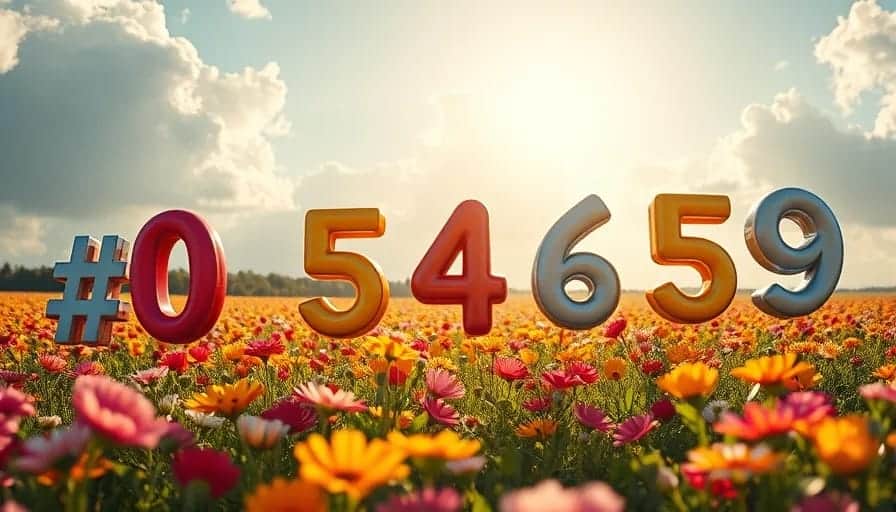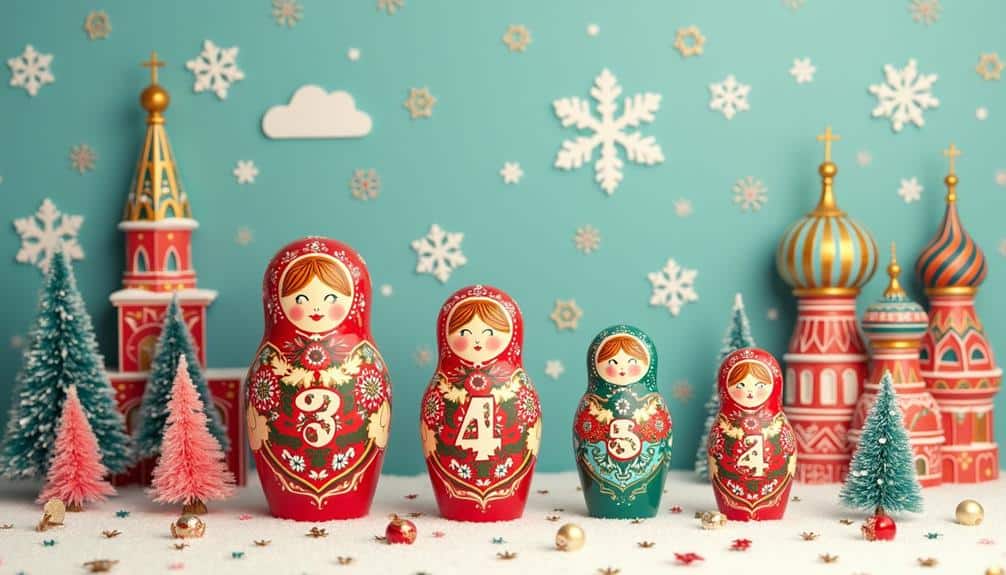Learning numbers in Russian involves understanding both cardinal and ordinal forms, starting from 0 (ноль) to 20 and beyond. Pronunciation precision, including stress placement, is vital for accuracy. Numbers 11 to 19 follow a specific suffix pattern (-надцать), while tens, hundreds, and thousands build upon base units for clarity. Practical applications include telling time, handling currency, and everyday communication. Cultural insights, like the significance of numbers 7 (семь) and 40 (сорок), add depth to numerical literacy. Mastering these foundational patterns provides a gateway to more complex numerical and linguistic constructs. Discovering the specificity of larger numbers illuminates further nuances.
Understanding Basic Numbers in Russian
Mastering basic numbers in Russian starts with cardinal numbers from 0 to 10, forming the foundation for further numerical skills. Progressing to numbers 11 to 20 introduces specific patterns that enhance comprehension and retention, crucial for practical communication in scenarios like telling time and shopping.
Cardinal Numbers from 0 to 10
The cardinal numbers from 0 to 10 in Russian are:
ноль (nol’)
один (a-deen)
два (dva)
три (tree)
четыре (che-ty-re)
пять (pyat’)
шесть (shest’)
семь (syem’)
восемь (vo-syem’)
девять (dyev-yat’)
To improve pronunciation, focus on soft and hard consonants and correct syllable stress. Use repetition, auditory and visual aids, and engaging activities like counting games or storytelling to reinforce learning. Recognizing cultural significance, such as the luck associated with the number семь (seven), can deepen understanding and make learning more enjoyable.

Cardinal Numbers from 11 to 20
After mastering 0 to 10, the next step is numbers 11 to 20:
одиннадцать (11)
двенадцать (12)
тринадцать (13)
четырнадцать (14)
пятнадцать (15)
шестнадцать (16)
семнадцать (17)
восемнадцать (18)
девятнадцать (19)
двадцать (20)
Recognizing patterns in number formation is pivotal for grasping the numerical system in Russian. The Russian numeral system exhibits distinctive number patterns that facilitate comprehension and usage. For example, the numbers 11 to 19 are constructed by combining the base digit (один for one, два for two, etc.) with the suffix “-надцать” (eleven through nineteen). This consistent digit combination underscores a fundamental aspect of the linguistic structure of Russian numbers.
From twenty onwards, understanding the patterns involves recognizing that multiples of ten (двадцать for twenty, тридцать for thirty, etc.) form the base, to which single digits are appended. For instance, twenty-one is “двадцать один,” directly translating to “twenty one.” This systematic approach adheres to mathematical principles, making it intuitive for learners to predict and form new numbers.
Additionally, the pattern of using compound forms, such as “сорок два” (forty-two), indicates a clear structure in higher numeral systems. Analyzing these digit combinations not only aids in memorization but also enhances numerical literacy in practical applications.
Counting Beyond Twenty
In extending numerical proficiency beyond twenty in Russian, it is imperative to understand the structure of tens (30, 40, 50, etc.) and their formation.
Additionally, combining numbers from 21 to 99 follows a specific pattern that integrates single digits with tens.
Special cases such as the number 100 and beyond introduce new numerical lexicon and syntactical rules that are essential for thorough mastery.
Tens: 30, 40, 50, and More
Mastering the Russian language requires a systematic approach to understanding its numerical system, particularly when counting beyond twenty. The tens—30 (тридцать), 40 (сорок), 50 (пятьдесят), and so forth—present unique challenges and opportunities for learners. Number pronunciation tips are vital; for instance, “сорок” distinctly differs from its counterparts, lacking a “дцать” suffix. This can lead to common number mistakes, such as confusing “сорок” with “четыре” (four).
Cultural number significance is another aspect worth noting. Numbers in Russian can carry connotations; for example, the number 40 is traditionally linked with mourning customs, highlighting the importance of cultural sensitivity.
Number related idioms also enrich the learning experience. For example, “сорок сороков” (forty forties) signifies a large, indefinite number, illustrating the idiomatic usage of numerals.
Effective strategies for memorizing numbers include mnemonic devices and repetition in context. Leveraging these techniques can enhance retention and ease of use.
Combining Numbers: 21 to 99
Steering through the complexities of combining numbers in Russian from 21 to 99 involves understanding the structural nuances and unique linguistic patterns inherent in the language. Unlike English, Russian constructs these numbers by articulating the tens and units separately, such as двадцать один (dvadtsat’ odin) for twenty-one. This pattern persists across the numerical spectrum up to ninety-nine.
Number pronunciation tips are essential here: accent placement and vowel reduction can greatly alter comprehension. For instance, сорок один (sorok odin) is pronounced with emphasis on the first syllable of “sorok.” Combining even numbers such as тридцать два (tridtsat’ dva) or пятьдесят шесть (pyat’desyat shest’) requires precision in enunciation to avoid common numerical mistakes, such as confusing “два” with “девять” due to similar terminal sounds.
Ordinal numbers usage is similarly fundamental; understanding that двадцать первый (dvadtsat’ pervyy) means twenty-first aids in practical applications like dates or ranking. Implementing practical counting exercises, such as counting objects or practicing dialogues, reinforces these concepts.
Special Cases: 100 and Beyond
Understanding the intricacies of combining numbers from 21 to 99 lays a solid foundation for advancing to higher numbers. Mastery of this foundational knowledge enables learners to explore the complexities of counting beyond the hundred mark.
In Russian, the hundred variations begin with “сто” (sto), which forms the basis for numbers 100 to 199. For example, 101 is “сто один” (sto odin), and 150 is “сто пятьдесят” (sto pyat’desyat).
As we progress to the thousand expressions, the word “тысяча” (tysyacha) becomes pivotal. Numbers such as 1,000 (тысяча) and 2,000 (две тысячи, dve tysyachi) demonstrate the formation principles, with subsequent numbers like 2,345 articulated as “две тысячи триста сорок пят” (dve tysyachi trista sorok pyat).
Beyond thousands, the million concepts utilize “миллион” (million), as seen in 1,000,000 (один миллион, odin million) and 1,500,000 (полтора миллиона, poltora milliona).
The billion interpretations follow a similar pattern, with “миллиард” (milliard) denoting billion in expressions like 1,000,000,000 (один миллиард, odin milliard).
These counting strategies, pivotal for advanced proficiency, enable learners to navigate complex numerical constructs in Russian, fostering an intuitive grasp of the language’s numerical framework.
Practical Uses of Numbers

Understanding the practical applications of numbers is vital for functional fluency in Russian. Key areas include telling time, which requires both cardinal and ordinal numbers, and engaging in everyday conversations where numerical information is frequently exchanged.
Additionally, proficiency in using numbers is essential for maneuvering shopping scenarios, particularly when understanding prices and handling transactions.
Telling Time in Russian
Mastering the art of telling time in Russian is essential for steering daily life and engaging in meaningful conversations. Time expressions in Russian exhibit unique linguistic constructs that differ considerably from English. Understanding both digital clocks and analog clocks is necessary for a thorough grasp of time-telling.
In Russian, the 24-hour format is typically used for digital clocks, aligning with military time conventions. For instance, 14:00 corresponds to 2:00 PM. Analog clocks, however, follow a more colloquial structure, often requiring the learner to recognize the half-hour and quarter-hour increments distinctly. For example, “половина третьего” translates to “half past two.”
Daily routines in Russian culture often hinge on precise time expressions. The phrase “без пятнадцати восемь” (fifteen minutes to eight) exemplifies how integral these expressions are.
Additionally, cultural differences manifest in the perception of punctuality and scheduling, where exactness is highly valued.
Acquiring proficiency in telling time in Russian not only enhances scheduling abilities but also deepens cultural immersion. By mastering these time expressions, one can navigate daily routines with ease and precision, ensuring effective communication in both professional and personal settings.
Using Numbers in Everyday Conversations
When traversing everyday conversations in Russian, the practical application of numbers is crucial. Numbers permeate various facets of daily communication, serving as fundamental tools for clarity and precision. For instance, numbers in greetings often manifest in inquiries about age, e.g., “Сколько вам лет?” (How old are you?). Responding accurately requires proficiency in age expressions, such as “Мне двадцать пять лет” (I am twenty-five years old).
Date formats in Russian follow a specific structure that demands understanding both ordinal and cardinal numbers. For instance, the date “April 5, 2023” is articulated as “пятое апреля две тысячи двадцать третьего года.” This format underscores the significance of numerical fluency in conveying temporal information.
Quantity descriptions are another critical aspect, especially when specifying amounts, e.g., “два яблока” (two apples) or “пять книг” (five books). Mastery of these expressions guarantees effective communication in various contexts, from casual conversations to more formal interactions.
Lastly, proficiency in reciting phone numbers in Russian is essential. Phone numbers are typically segmented into groups, such as “8 (495) 123-45-67,” demanding clear enunciation and comprehension. Therefore, integrating these numerical applications enhances overall communicative competence in Russian.
Numbers in Shopping and Prices
In everyday conversations, numeric proficiency seamlessly extends into the domain of shopping and pricing, where numbers are integral to various transactions. Mastery of shopping vocabulary essentials is essential for effective communication in Russian markets. Phrases such as “сколько стоит?” (How much does it cost?) and “могу я получить скидку?” (Can I get a discount?) are indispensable.
Understanding common currency terms, like “рубль” (ruble) and “копейка” (kopeck), is fundamental for accurate financial dealings.
Advanced price negotiation strategies require not only linguistic accuracy but also cultural sensitivity. In Russia, negotiating prices is less common than in other cultures, but knowing expressions for discounts, such as “скидка” (discount) and “специальная цена” (special price), can be beneficial. Moreover, being adept at discussing numerical specifics fosters confidence in transactions.
Effective budget planning tips involve a clear comprehension of prices and quantities. Utilizing numbers to track expenses, set financial limits, and compare costs guarantees efficient and informed decision-making. For instance, understanding “цена за килограмм” (price per kilogram) aids in evaluating bulk purchases.
Cultural Insights Related to Numbers

Understanding the cultural significance of numbers in Russian society offers valuable context for learners.
Numbers hold particular meanings in various traditions and expressions, such as the avoidance of the number 13 due to superstition and the celebratory significance of 7 in birthdays and anniversaries.
Additionally, proverbs and idioms involving numbers provide insights into Russian cultural practices and social norms.
Significance of Numbers in Russian Culture
Numbers hold significant cultural and symbolic meanings in Russian society, reflecting historical, religious, and superstitious elements. Numerical symbolism in Russia spans from ancient traditions to contemporary beliefs. For instance, the number seven is often considered a lucky number due to its historical significance in both religious texts and folklore. It is frequently associated with good fortune and divine intervention.
Conversely, the number thirteen is viewed with apprehension, aligning with broader global number superstitions. The mathematical traditions within Russian culture, particularly during the Soviet era, emphasized the importance of numbers in scientific and technological advancements, further embedding them into the societal fabric.
Moreover, numbers like three and nine possess unique cultural connotations. The number three is deeply rooted in Russian Orthodoxy, symbolizing the Holy Trinity, while the number nine often appears in rituals and memorial customs, highlighting its spiritual resonance.
Understanding these numerical nuances offers valuable insights into Russian culture, providing an enriched perspective on their historical and social paradigms.
Common Expressions Involving Numbers
Common expressions involving numbers in Russian provide fascinating insights into the language and culture. Analyzing number idioms reveals a nuanced understanding of numeric symbolism and its historical significance.
For example, the phrase “семь пятниц на неделе” (seven Fridays in a week) describes an unreliable person, reflecting the cultural association of Friday with inconsistency. Similarly, the idiom “один в поле не воин” (one is not a warrior in the field) underscores the importance of teamwork, illustrating numeric symbolism in collective effort.
Superstitious beliefs also permeate Russian number expressions. The number 13, known for its global superstition, is avoided in many contexts, while the number 7 is often considered lucky, resonating with spiritual and mystical connotations.
Age expressions such as “встать на ноги в 30” (to stand on one’s feet by 30) highlight societal expectations of maturity and stability at specific ages.
Additionally, historical significance is embedded in expressions like “пять копеек” (five kopecks), symbolizing a trivial contribution or opinion, rooted in currency history.
These number idioms and expressions not only enrich linguistic competence but also offer a profound understanding of Russian cultural paradigms.
Celebrations and Traditions with Numbers
In Russian culture, numbers play a pivotal role in various celebrations and traditions, reflecting deep-rooted beliefs and historical influences. Number rituals are integral to festive gatherings, often embodying symbolic meanings that permeate the cultural fabric.
For instance, the number three holds profound significance, symbolizing completeness and harmony. This numerology belief is evident in numerous traditional practices, such as the three kisses exchanged during greetings and toasts at social events.
Traditional games also incorporate numbers to enhance communal experiences. During the holiday of Maslenitsa, games involving counting and coordination, like “gorodki” (a bat-and-ball game), emphasize numerical precision.
Similarly, the New Year’s Eve ritual of making twelve wishes—one for each chime of the Kremlin clock—demonstrates the cultural importance of numbers in marking time and aspirations.
Moreover, numerology beliefs influence personal and communal decisions. The number seven, often associated with good fortune, is frequently chosen for significant life events, including weddings and business ventures.
Understanding these numerical traditions provides essential insights into Russian cultural practices and offers innovative perspectives on the role of numbers in shaping societal behaviors and communal identities.




